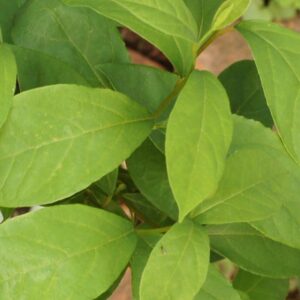Showing the single result
Wholesale Spicebush Shrubs in Michigan
Cold Stream Farm is a wholesale supplier of Spicebush shrubs based in Free Soil, Michigan. Our Spicebush shrubs are available at no minimum quantity both as transplants and bare-root seedlings. From our farms in Michigan to your property in the US or Canada, we proudly ship Spicebush shrubs, primarily in the spring.
What to Know Before You Purchase Spicebush Shrubs
Before you purchase a single Spicebush shrub (Lindera benzoin) or a larger shipment, it is important to become familiar with the characteristics of the plant to ensure it fits your property’s conditions and needs.
A Quick Background of Spicebush
Spicebush shrubs are a very common plant native to eastern North America, growing naturally from Texas to Florida, up to Maine and Ontario.
Depending on the region, Spicebush plants may be referred to using many different names. Other common names for Lindera benzoin include wild allspice, Benjamin bush, Spicewood, Common Spicebush, and Northern Spicebush. A “spice” bush gets its name from the powerful aroma that is emitted when the plant’s leaves are crushed. The camphoraceous aroma is said to smell like fruit, citrus, and spice.
Size and Appearance
Most Spicebush shrubs will slowly grow to reach a mature height of anywhere from 8 to 12 feet. The bushes have equal height and width and often grow in thickets made of plant clumps because of root sprouting. During the spring and summer, the plant’s leaves are dark green on top and paler on the bottom, without any sharp edges. In bloom, the flowers are bright yellow and when ripe, a Spicebush berry is a dark shade of red. There are no thorns on Spicebush stems, but the flat bark is covered in small bumps, which make the branch surface very rough.
A Year in the Life of a Spicebush Shrub
Beginning in the middle of spring, a Spicebush will bloom its bright yellow, aromatic flowers in late March, April, and early May. Come summertime, seed and fruit production will commence, eventually maturing as early as August and September.
In the fall, the leaves of a Spicebush shrub turn very yellow before shedding for the winter. By winter, the bare tree’s berries are then browsed and eaten by many animal and bird species.
Ideal Growing Conditions
Spicebush shrubs are relatively hardy plants, able to best grow in USDA zones 4-7. Within these areas, Spicebush can grow very successfully in partial shade conditions but is ideally placed in full sun. With complete exposure, Spicebush shrubs can grow both quicker and denser than in shady conditions.
Although they are quite common in the wild, Spicebushes need a significant amount of moisture in the soil to live. They are not very resistant to drought conditions and grow best in moist, rich, and well-drained soils. Growing naturally, Spicebush is most often found in swamp margins, near streams, and in low wooded areas.
The Benefits and Uses of Spicebush
Providing a colorful palette all year round, Spicebush shrubs are grown most often as an ornamental plant in a garden. The distinct smell of Spicebush flowers will add a bit of spice to the air and attract colorful butterflies and moths.
It is also possible to make Spicebush tea by crushing up the plant’s new stems, leaves, and buds. In cooking, mature Spicebush fruit can be ground up and used as a substitute for ordinary allspice.
What’s more, the decoction of Spicebush bark has been used medicinally both in ancient and modern applications. The secreted substance is said to help in arthritis, typhoid fever, intestinal worms, and more.
Wildlife and Ecology
Aromas and fruits attract a significant amount of birds, butterflies, moths, and mammal species to snack on Spicebush plants. Most commonly, visitors include hermit thrushes, game birds, deer, rabbits, opossums, songbirds, and more. After eating the fruit and digesting the seeds, birds and small mammals help propagate Spicebush through dispersion.
Hosting moths and other insects at all stages in their life, it is very common to see caterpillars, cocoons, and fully grown butterflies on and around Spicebush thickets.
Common Challenges with Growing Spicebush
As they attract a lot of critters, Spicebush plants may become damaged by over-browsing an immature shrub. Other than that, there are no real disease or insect-related illnesses that are common among Spicebush plants.
Bonus Spicebush Fun Facts
Spicebush plants are dioecious, meaning male and female flowers grow on separate plants. They are very long-lasting plants, living for up to 20 years at a time in the wild!
Get Started with your Spicebush Shrub Shipment.
If you are interested in purchasing one or more of these plants, please check our current availability for Spicebush (Lindera benzoin). In general, Spicebush shrubs over one foot tall are only available in the spring, with smaller transplants available year-round. Cold Stream Farm ships directly from our property in Free Soil, Michigan. Please contact us today if you have any questions about your next Spicebush shipment.


